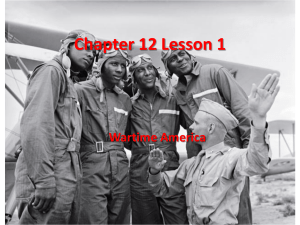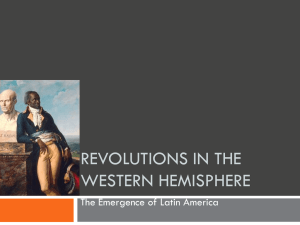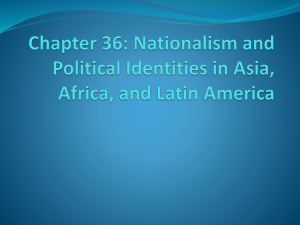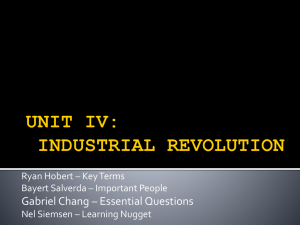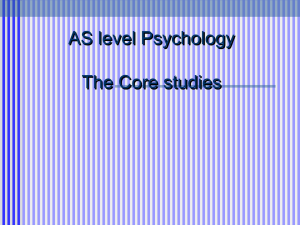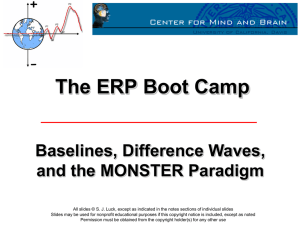Review Questions PPT - Mrs. Thiessen`s Social Studies Classes
advertisement
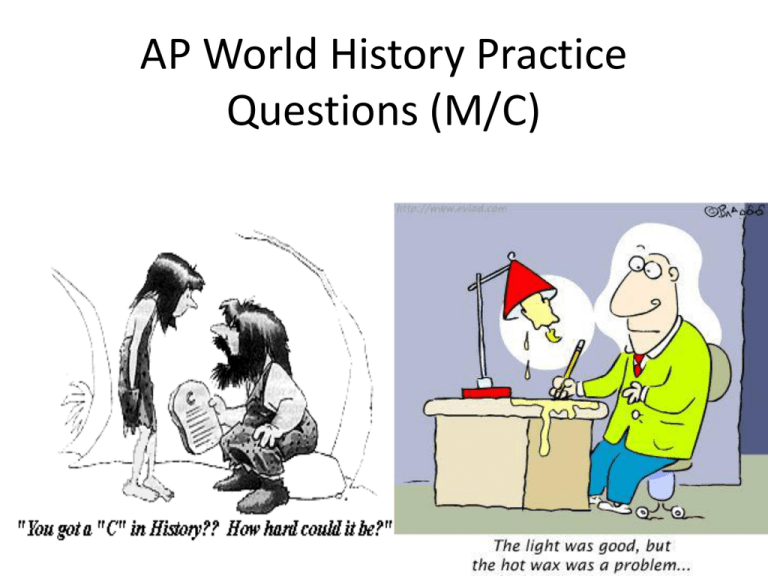
AP World History Practice Questions (M/C) • 1. Which of the following was the major effect of the Neolithic Revolution? • (A) The establishment of sedentary village communities • (B) The spread of a migratory way of life • (C) A decline in total population • (D) An increase in the use of bronze tools • 2. Which of the following occurred as a result of the development of agriculture in societies that previously relied on hunting and gathering? • (A) Conditions for women improved. • (B) The incidence of disease declined. • (C) Population density increased. • (D) Degradation of the environment lessened. • 3. Which of the following was an important reason for the fall of the Roman, Han, and Gupta empires? • (A) A long period of drought that destroyed crops and livestock • (B) The use of slaves in their armies • (C) Intensified invasions and security issues along their frontiers • (D) A refusal to tolerate Christianity • 4. Before 500 C.E. Judaism and Hinduism were similar in that both • (A) had written scriptures and an ethical code to live by • (B) spread widely around the Mediterranean • (C) promoted teachings about reincarnation • (D) advocated a monastic life and a rejection of the world • 5. The photograph above of a mosque (first erected in the fourteenth century) in the modern-day West African country of Mali best exemplifies which of the following historical processes? • (A) Imposition of religion through military conquest • (B) Spread of religion along trade routes • (C) Abandonment of indigenous cultural styles in the face of colonization • (D) Conflict between local and universalizing religions • 6. The spread of Bantu-speaking peoples over southern Africa before 1400 C.E. can be best explained by their • (A) conversion to Islam • (B) use of cavalry • (C) centralized political systems • (D) knowledge of agriculture • The Crusader states were able to cling to survival only through frequent delivery of supplies and manpower from Europe. [They] were defended primarily by three semi-monastic military orders: the Templars, the Hospitallers, and the Teutonic Knights. Combining monasticism and militarism, these orders served to protect pilgrims and to wage perpetual war against the Muslims. Palmira Brummett, world historian, 2007 • Whenever I visited Jerusalem, I always entered the al-Aqsa Mosque, beside which stood a small mosque which the Franks had converted into a church.… [T]he Templars, … who were my friends, would evacuate the little adjoining mosque so that I could pray in it. Usamah ibn Munqidh, Muslim historian, Jerusalem, circa 1138 • 7. The second passage does not support the first passage because the second passage • (A) shows that an influx of manpower from Europe was not critical for the survival of the Crusader states • (B) shows that Muslims vastly outnumbered Europeans in the Crusader states • (C) minimizes the importance of Hospitallers and Teutonic Knights in the administration of the Crusader states • (D) presents an incident in which a military order supported a Muslim traveler • 8. Inca and Aztec societies were similar in that both • (A) developed from Mayan civilization • (B) acquired empires by means of military conquest • (C) independently developed iron technology • (D) depended entirely on oral record keeping • 9. Which of the following factors represents the most significant cause of the growth of cities in Afro-Eurasia in the period 1000– 1450? • (A) Climate change • (B) Increased interregional trade • (C) Decreased agricultural productivity • (D) Increased invasions • 10. The map above shows what significant economic developments? • (A) Trade connections that linked the Hellenistic and Maurya empires to African cities from 300 through 150 B.C.E. • (B) Trading networks that promoted the growth of new cities from 600 C.E. through 1450 C.E. • (C) Chinese dominance of Indian Ocean trading networks because of the voyages of Zheng He in the 1400s C.E. • (D) Changes in Indian Ocean trading networks that resulted from technological innovations from 1450 C.E. through 1750 C.E. • 11. Which of the following changes best justifies the claim that the late 1400s mark the beginning of a new period in world history? • (A) The rise of the Aztec and Inca empires • (B) The economic recovery in Afro-Eurasia after the Black Death • (C) The incorporation of the Americas into a broader global network of exchange • (D) The emergence of new religious movements in various parts of the world • 12. The Columbian Exchange involved which of the following new connections in the era 1450–1750? • (A) European food to the Western Hemisphere; Western Hemisphere diseases to Europe; African population to Europe • (B) Western Hemisphere technology to Africa; African food to Europe; European population to the Western Hemisphere • (C) European technology to Africa; Western Hemisphere population to Africa; African food to the Western Hemisphere • (D) African population to the Western Hemisphere; Western Hemisphere food to Europe and Africa; African and European diseases to the Western Hemisphere • 13. In the period 1450–1750, which of the following, produced on large plantations by slave labor, were significant commodities in the growing world market? • (A) Grains such as wheat and barley • (B) Tropical fruits such as bananas and oranges • (C) Animal products such as wool and beef • (D) Cash crops such as sugar and tobacco • 14. Which of the following is most likely to have influenced eighteenth-century population trends in both Europe and China? • (A) A sharp decline in average global temperatures • (B) Introduction of Western Hemisphere crops • (C) Innovation in birth control measures • (D) Improvement in surgical procedures • 15. Which of the following factors best explains why the Portuguese did not engage in direct trading relations with West African states until the fifteenth century? • (A) Lack of the necessary navigational and maritime technology • (B) Lack of European interest in African goods • (C) Directives from the pope to limit trade between Christians and Africans • (D) Fear of death from tropical diseases • 16. In recent decades, many world historians have challenged the commonly held view that Europeans controlled the largest share of world trade in the seventeenth through the eighteenth centuries. Which of the following evidence from the period would best support this historical reinterpretation? • (A) Prices for Chinese goods were much higher in Europe than in China. • (B) European trading companies often backed their long-distance trading ventures with the threat of military force. • (C) Asian trading companies dominated trade in the Indian Ocean region. • (D) European merchants transported only a fraction of the goods shipped globally. • 17. Which of the following would be the most useful source of evidence for research about the profits of Portuguese and British slave traders in the period 1600–1800? • (A) Portuguese and British tax records • (B) Narratives of slaves transported to the Americas • (C) European slave traders’ account books • (D) Journals of African slave traders • I am a griot.… we are vessels of speech; we are the repositories which harbor secrets many centuries old. Without us the names of kings would vanish into oblivion. We are the memory of mankind; by the spoken word we bring to life the deeds and exploits of kings for younger generations.… I teach kings the history of their ancestors so that the lives of the ancients might serve them as an example, for the world is old, but the future springs from the past. An African griot (storyteller), circa 1950, introducing the oral epic of King Sundiata of Mali, composed circa 1400 C.E. • 18. The introduction by the griot is intended to serve which of the following purposes? • (A) To establish the griot’s authority by connecting him to the past • (B) To exalt the Malian kings above previous dynasties • (C) To highlight the griot’s unique abilities compared with other griots • (D) To portray Mali as a progressive society that is improving on the past • 19. Which of the following statements is true about both the Mughal and Ottoman empires in the sixteenth century? • (A) In both empires the majority of the people were Muslims. • (B) Both empires had powerful navies that engaged European navies. • (C) Both empires expanded through the use of gunpowder weapons and extensive bureaucracies. • (D) Both empires gave little monetary support to artistic and cultural endeavors. • 20. Most world historians would agree that the key to European predominance in the world economy during the nineteenth and early twentieth centuries was • (A) the Industrial Revolution • (B) European medical technology • (C) Spanish control of New World silver • (D) the Enlightenment • 21. Which of the following developments in the period 1878–1922 best explains the change in Japanese trade patterns? • (A) Japanese manufacturing output decreased because Japanese leaders restricted commercial ties. • (B) Export of manufactured goods declined because United States tariffs on Japanese goods increased. • (C) Japanese manufacturing output rose as a consequence of industrialization. • (D) Japanese imports of raw materials increased as a consequence of extensive immigration to Japan. • 22. In contrast to initial industrialization, the second Industrial Revolution in the last half of the nineteenth century was particularly associated with the mass production of which of the following? • (A) Textiles, iron, and coal • (B) Textiles, automobiles, and plastics • (C) Airplanes, ships, and radios • (D) Electricity, steel, and chemicals • 23. All of the following factors contributed to significant growth in worldwide population from 1750 through 1900 EXCEPT • (A) decline of epidemic disease • (B) introduction of Western Hemisphere food crops to new areas • (C) expansion of land under cultivation • (D) new grain crops developed in the Green Revolution • 24. Between 1750 and 1900, which of the following industrializing states created an empire? • (A) Japan • (B) China • (C) Brazil • (D) Argentina • 25. In the late nineteenth century, European involvement in both Africa and China was characterized primarily by • (A) the encouragement of slavery • (B) extensive intermarriage with local peoples • (C) small military enclaves along coastlines • (D) competition among imperialist powers • 26. Which of the following European developments is most closely associated with the revolution in Haiti? • (A) The Protestant Reformation • (B) The Russian Revolution • (C) The French Revolution • (D) The Industrial Revolution • 27. The North and South American independence movements of the late eighteenth and early nineteenth centuries shared which of the following? • (A) Revolutionary demands based on Enlightenment political ideas • (B) Reliance on Christian teachings to define revolutionary demands • (C) Industrial economies that permitted both areas to break free of European control • (D) Political instability caused by constant warfare among the new states • 28. What was the leading cause of the unprecedented increase in global population in the twentieth century? • (A) The end of international epidemics • (B) Global warming and other types of climate change • (C) The impact of medical innovations and public health measures • (D) The reduction of world hunger • 29. “We shall not repeat the past. We shall eradicate it by restoring our rights in the Suez Canal. This money is ours. The canal is the property of Egypt.” This quotation by Egyptian leader Gamal Abdel Nasser (in power 1952– 1970) best expresses support for • (A) communism • (B) liberalism • (C) nationalism • (D) imperialism • 30. Which of the following describes a major change in international relations in the 1980s and 1990s? • (A) The rapid establishment of large overseas colonial empires by European powers • (B) The disbanding of most regional political organizations • (C) The decline in power of multinational corporations • (D) The reduction of confrontations between communist and noncommunist countries What was the Boxer Rebellion? What is this illustrating? • Which of the following would have been outside the sphere of Mongol control at its height? – – – – – China Anatolia Persia Mesopotamia Germany • Which long-distance trade network was stabilized in the period historians term the Pax Mongolica? – – – – – Indian Ocean routes Triangular trade routes East Asian sea routes Silk Roads Trans-Sahara route • How were individuals selected for leadership in traditional Mongol society? – – – – – Hereditary warrior lineage Long-established aristocratic status Merit system based on demonstrated battlefield bravery Divine revelation of chosen ones Social status based on number of goats, sheep, and horses owned • Which of the following dealt the most devastating blow to the Abbasid caliphate in particular and Islamic civilization in general? – – – – – Christian crusader incursions in the Near East Ottoman Turkic conquest of Constantinople Mongol invasion of Mesopotamia US invasions of Iraq and Afghanistan after 9/11/01 Portuguese defeat of the Ottoman navy • Which military innovation did the Mongols expose Europeans to for the first time? – – – – – The catapult The siege tower The battle axe Cavalry units Gunpowder • Which global force was the FIRST to consistently integrate sub-Saharan Africa into a global network of exchange of goods and ideas? – – – – – Islamic civilization Modern globalization Transatlantic slave trade The Roman Empire The conquests of Alexander • Which of the following does NOT belong in a list of features of a stateless society? – – – – – Delayed ability to respond to external threats Limited ability to mobilize for war Mass slave revolt Difficulty in undertaking large building projects Lack of stability required for consistent and growing long-distance trade • Since the classical era, which African region most accurately fits the description “gateway of the Middle East”? – – – – – Ghana Zimbabwe Egypt Congo Sudan • Which African society held on most fiercely to Christianity in the period of Islam’s expansion in Africa? – – – – – Egypt and Ethiopia Mali Ghana Songhai Tunisia • Which of the following materials is most associated with premodern sub-Saharan African artistic expertise? – – – – – Marble Oil paints Mosaic tile Ivory Jade • Which religious schism stemmed from disputes over legitimate succession of leadership after the death of its key or founding figure? – – – – – Eastern Orthodox and Catholic Catholic and Protestant Mahayana and Theravada Sunni and Shia Mahayana and Zen • Which best qualifies as the largest durable tricontinental civilization? – – – – – Roman Hellenistic Islamic Han Mongol • Upon whom did Muhammad depend most directly for economic support? – – – – – Local chieftains The urban poor His wife, Khadija Roman imperial administrators Byzantine merchants • Which of the following Arabic terms refers to the “community of the faithful”? – – – – – Hijab Hajj Hadith Zakat Umma • Who would NOT have qualified as part of the group labeled the “dhimmi” in the Abbasid caliphate? – – – – – Jews Catholics Greek Orthodox Animist Hindu • Which choice does NOT belong in a list describing the status of Muslim women in the early Islamic period? – – – – – Male adultery was condemned in the Koran Female infanticide was forbidden Females and males both were allowed multiple spouses Female inheritance rights were strengthened Divorce rights for women existed • Which city became the capital of the Abbasid Empire and a center of what has been termed an Islamic golden age? – – – – – Istanbul Timbuktu Seville Baghdad Samarkand • Which of the following areas of expertise or learning progressed under the rule of the Abbasid caliphate? – – – – – Medicine Law Philosophy Mathematics All of the above • The Byzantine Empire flourished as a crossroads of trade from which regions? – – – – – Mediterranean, the Middle East, and Asia India, Mediterranean, and Asia Sub-Saharan Africa, India, and the Middle East The Middle East, Asia, and Scandinavia Scandinavia, Mediterranean, and India • Which ideology gained influence in the period of disorder that followed the collapse of the Han dynasty? – – – – – Confucianism Buddhism Daoism Mao Zedong thought Legalism • Which dynasty built the largest land empire? – – – – – Zhou Han Tang Song Ming • Which do historians point to as the key infrastructural development of the Tang-Song era? The construction of: – – – – – The Great Wall A national highway system The Forbidden City The Grand Canal The port at Canton • Which practice dates from the Song era? – – – – – Foot binding Arranged marriage Concubinage Divorce rights One-child policy • Which of the following is not a native Chinese invention? – – – – – Explosive powder Magnetic compass Movable type Paper money Steam-powered machinery • Which contemporary society most closely mirrored feudal Japanese patterns of decentralized rule, an economy based on agricultural peasant labor, and emergence of a warrior elite following a distinct code of honor? – – – – – Polynesian Inca Western European Russian Islamic • Which of the following do historians most closely associate with the period of Western history known as the High Middle Ages? – – – – – Carolingian France Steam-powered Industrial Revolution Enclosure movement and rise of commercial agriculture Gothic architecture, the Crusades, & the rise of the Western university Frequent Viding incursions and raids along European coastlines and rivers • Which group was most likely to be literate in the period of European history often called the Dark Ages? – – – – – Aristocrats Peasants Monks Knights Monarchs • Which of the following terms matches this definition: “agricultural laborer tied to an estate with rights including military protection, heritable ownership of a plot of land, and owing obligations to share crop yields each season with his or her lord.” – – – – – Peasant Slave Proletarian Serf Plebian • Which of the following does NOT belong in a list of territorial expansionary moves by Western powers in the postclassical era? – – – – – Germanic settlement in Poland Iberian offensives against Islamic presence in Spain Crusades to the Middle East Viking voyages across the North Atlantic Belgian penetration of the Congo • Which term do historians associate with medieval Western inquiry that sought to reconcile reason and religious faith and is most closely associated with the thinking of St. Thomas Aquinas? – – – – – Confucianism Existentialism Scholasticism Eclecticism Marxism • Which body of water was the scene of trade involving merchant ships from the most diverse collection of civilizations in the postclassical era? – – – – – Atlantic Ocean Pacific Ocean Baltic Sea Indian Ocean Caribbean Sea • Which of the following organizations grouped town dwellers by occupation, regulated apprenticeships, and upheld standards of workmanship? – – – – – Parliaments Estates General Guilds Communes Monasteries • Of those listed below, which civilization existed in the most complete state of isolation in the period 600-1450? – Ming China – Delhi Sultanate – Aztec Empire – Carolingian France – Kievan Rus • Which of the following does NOT belong in a list of factors preventing European powers from establishing anything more than a limited coastal settlement on the African continent in the period 1450-1750? – – – – – Climate Disease Impassable rivers Still organized African resistance Inferior weapons technology • Which European power was the first to establish large-scale slave-trading operations on the African continent for the purposes of export to plantations in the Americas? – – – – – Spain England Portugal France Netherlands • The Afrikaners who settled in southern Africa traced their origin back to which European region? – – – – – England Germany Netherlands France Spain • Which is most true of the Middle Passage? – It was generally a pleasant voyage – Mortality on marches to the African coast was higher than mortality on the ships – It generally lasted a year or more – African naval expertise was key to guiding vessels across the Atlantic – It was not driven by profit • Where in the New World did slavery last the longest? – – – – – Haiti Brazil Cuba The USA Mexico • Which Western power was the first to ban its citizens from engaging in the slave trade? – – – – – France England USA Portugal Spain • Which Western tradition did the continuation of the Atlantic slave trade violate most? – – – – – Enlightenment Greco-Roman Feudal Mercantilist Absolutist • The shift of the Russian imperial capital to which city indicated a shift in orientation toward the West under the rule of Peter the Great? – – – – – Moscow Kiev Vladivostok St. Petersburg Belgrade • Which impulse for the colonization of North America was generally missing from the colonization of the rest of the New World? – – – – – Setting up slave plantations To search for gold Freedom from religious persecution Expansion of royal authority Missionary drive to convert Native Americans to Christianity • The economic centrality of long-distance trade and the lack of long feudal traditions opened a path for which social class to rise to dominance relatively quickly in the New World? – – – – – Independent farmer/peasant Proletarian Merchant Aristocracy Monarchy • Which region of the New World saw the initial penetration by European explorers and subjugation of the Native population to slave labor? – – – – – Mesoamerica Andean South America Caribbean Islands Atlantic shoreline of North America Atlantic shoreline of South America • Which New World commodity was of the greatest value to the Spanish monarchy? – – – – – Potato Tomato Silver Sugar Quinine • Which label best characterizes the Italian Renaissance? – – – – – Political movement Cultural movement Religious movement Mass movement Global movement • Which modern-day European nation projects farthest west off the Eurasian landmass and into the Atlantic Ocean? – – – – – Germany France England Portugal Netherlands • Where did Luther’s movement first take root? – – – – – France England Spain Italy Germany • Who is credited with bringing awareness of the heliocentric nature of the solar system into Western civilization? – – – – – Aristotle Galileo Columbus Copernicus Descartes • Which of the following thinkers established the principles of objects in motion and defined the forces of gravity? – – – – – Descartes Rousseau Newton Bacon Galileo • Which event established the basic sovereignty of Parliament over the king of England? – – – – – Reform Act of 1832 The Corn Laws The Magna Carta The Glorious Revolution The American Revolution • Which of the following was a new Western motive for overseas territorial expansion in the industrial era? – – – – – Missionary drive to convert non-Western peoples to Christianity Seizure of land to be put to use raising cash crops Drive to dominate sources of precious metals. Need for raw materials for factory production Access to new markets for sale of Western manufactured goods • Which European power did the British defeat in the 18th century in its drive to control the Indian subcontinent? – – – – – Netherlands France Italy Spain Portugal • Which choice lays out the correct order in which the Industrial Revolution began and spread? – – – – – Great Britain, USA, continental Europe Continental Europe, USA, Great Britain USA, continental Europe, Great Britain Great Britain, continental Europe, USA Continental Europe, Great Britain, USA • Which group emerged at the peak of French social status as a result of the French Revolution? – – – – – Urban proletariat and artisans Aristocracy Clergy Bourgeoisie Peasantry • Historians estimate the numbers of victims in the Reign of Terror in roughly what figures? – – – – – Hundreds Thousands Tens of thousands Hundreds of thousands Millions • Which of the following was NOT an influential political force in Europe by the late 19th century? – – – – – Feminism Social Democracy Socialism Anarchism Absolute monarchy • After the US, which was the next New World colony to gain independence from European power? – – – – – Mexico Argentina Brazil Haiti Cuba • On what continent did the USA fight its two largest conflicts of the Cold War era? – – – – – Europe Asia Africa Australia South America • Mao’s campaign to infuse industrial development into the national economy at the commune level was called – – – – – New Democracy Protracted Warfare “Hundred Flowers” period The Long March The Great Leap Forward • Which formally colonized country has taken the most drastic measures to limit population growth? – – – – – Mexico Nigeria India China Egypt • Which f the following is NOT among the “Four Modernizations” put forward by Deng Xiaoping as key to economic self-reliance and emergence of China as a world power by the early 21st century? – – – – – Agriculture Industry Science and Technology Classless society National defense • Neocolonialism is best defined as – Western efforts to expand colonial holdings after the Second World War. – The ongoing situation of economic dependency that afflicts “Third World” even after decolonization – The post-WW II population boom in “Third World” – A description of the Soviet relationship with satellite states of Eastern Europe during the Cold War – All colonization that occurred after Latin American nations won independence from Spain • Which is an impact of population growth in the developing world? – – – – – Declining importance of the IMF in the global economy Falling numbers of refugees Rapid and haphazard urbanization Rising status for females Reduced population levels • Which goal did nationalist leaders find most difficult to achieve upon gaining independence? – – – – – Economic development and jobs for all Maintenance of territorial integrity of the new nations Participation in world trade Membership in the UN Establishment of secular government • Which was the most typical response of nationalist leaders in developing countries to popular unrest connected to persistent poverty and/or ethnic strife? – – – – – Requests for the return of Western colonial management A turn to military dictatorship Free and air elections of new leaders capable of resolving major grievances Establishment of new international borders to appease minority ethnicities The launching of armed struggle against established elites and the setting up of socialist regimes • Which of the following is NOT a trend or event associated with developments in post-WW II Egypt? – – – – – Expulsion of the British from the Suez Canal Zone Construction of the Aswan dam Growth of Islamic fundamentalism Establishment of state-subsidized public education Successful import-substitution industrialization • Which of the following statement about the Iranian Revolution of 1979 is most accurate? – – – – – It marked the end of British colonialism in Iran It overthrew a monarchy and installed a liberal democracy It was guided by a non-Western ideology It was welcomed by neighboring nations Its leaders withdrew Iran from OPEC • Which of the following was the only newly independent nation to experience civil war secession and the formation of another nation within decades of decolonization? – – – – – Sudan South Africa Mexico Pakistan Nigeria • Which natural resource or crop have developing nations been able to trade in the global economy on terms most favorable to themselves? – – – – – Cocoa Coffee Oil Diamonds Aluminum • Nelson Mandela and Steven Biko are associated with the struggle against what? – – – – – Soviet socialism South African apartheid US imperialism French colonialism German fascism • Which of the following was the first group targeted by the Nazis for repression once they seized power in Germany? – – – – – Jews Communists Gypsies Homosexuals Small-business men • Which was the 1st fascist dictator? – – – – – Friedrich Nietzsche Adolf Hitler Benito Mussolini Vladimir I. Lenin Martin Heidegger • Which was the first 20th century revolutionary movement to successfully topple an existing regime? – – – – – • Iranian Chinese Mexican Russian French How were minority ethnic groups of the old Russian Empire treated by the new Bolshevik regime? – Most individuals belonging to minorities experienced forced deportation to Siberia – Minority groups were granted semiautonomous republics bound to pursuing a socialist course – Minority ethnicities were forcibly intermarried with ethnic Russians to breed them out of existence – All minority groups were granted “Soviet Socialist Republic” territory except for Jews – Ethnic minorities were barred from membership in the Bolshevik Party • Which political figure eventually emerged to lead the Bolshevik Party after the death of Lenin? – – – – – Trotsky Khrushchev Gorbachev Stalin Bukharin • Which factor in the Russian and Chinese revolutions was NOT present in the French Revolution? – – – – – Rural unrest Urban discontent Military intervention by neighboring or outside powers The ideas of Marx and Engels Armed struggle • Where in the world did the Japanese most vigorously seek to achieve territorial expansion in the years following 1914? – – – – – Korea Mongolia Indonesia Pacific Islands China • Which development prompted Chinese nationalists and communists to suspend civil war and form a shaky common cuase? – Death of Sun Yat-sen – Japanese invasion of China – Massive American investment to build up industrial sectors in Chinese urban centers – Communist long march to sanctuary in nationalist base areas in northwest China – Historic summit meeting between Chiang Kai-shek and Mao Zedong • In which nation did parliamentary democracy survive the 1930s? – – – – – Spain Germany France Brazil Italy • The growing integration of all the peoples of the planet into a single economic and political model and accelerating sharing of cultural symbols in termed – – – – – Egalitarianism Simulacra Postmodernism Globalization Universalism • Which is the most popular and accessible method worldwide of accessing the efficiencies of a new “information economy”? – – – – – Mobile phones Personal computers Local libraries Satellite television Major newspapers • What was the nationality of the majority of 9/11 hijackers? – – – – – Iraqi Palestinian Saudi Arabian Afghan Iranian • How are the nations of Latin America unique within the “Third World”? – – – – They have struggled to emerge from a dependent role in the global economy They have experienced civil war in the post-WW II era They gained political independence in the 19th century, in general They continue to use a language imposed by colonial administrators in internal state affairs. – Women have risen to high levels of political leadership • Which independent developing- country regime entered what is best termed as a dependent economic relationship with the Soviet Union that lasted until the collapse of the USSR in the early 1990s? – – – – – Ghana Egypt India Zaire (Congo) Cuba • When compared with the case of Mexico in the years since WW II, the people of Cuba have experienced greater progress in each of the following EXCEPT: – – – – – Job security Housing Literacy Life expectancy Emigration rights • How did the Catholic church leaders demonstrate sensitivity to demands of the poor for social justice in 20th century Latin America? – Demanding special infusions of charity from the Vatican that wiped out poverty in their parishes – Formulation of a “liberation theology” – Organization of sophisticated adoption schemes whereby the majority of children in poverty in Latin America were adopted by middle-class families in the West and sent to live there – Renunciation of Christianity in favor of orthodox Marxist socialism – Entering national elections, winning, and implementing land reform policies. • Which is the most common pattern of migration in the Americas today? – From North America into Latin America – From Latin American countryside to Latin American cities – From Latin American cities into the Latin American countryside – From Latin America into North America – Out of the Americas to Europe • Which of the following nations did not succumb to military rule in the post-WW II era? – – – – – Bolivia Mexico El Salvador Argentina Venezuela • The USA pursued its interests in Latin America after WW II in all of the following forms EXCEPT: – – – – – Direct annexation Covert action to overthrow regimes perceived to be Soviet friendly Diplomatic pressure in international organizations Peace Corps presence The IMF and World Bank • NAFTA has more closely integrated the economies of Canada, the US, and – – – – – Russia China Mexico Venezuela Brazil • Which of the following periods have been grouped together by world historians into a time called an “Age of Catastrophe” lasting from 1914 to 1945? – – – – – WW I, Great Depression, Cold War Napoleonic Wars, WW I, WW II WW I, Great Depression, WW II WW II, Cold War, post-Cold War era Great Depression, WW II, Cold War • Which of the following trends were seen in the 20th century? – Rise and fall of communism and political independence for the former colonies – Rise and fall of communism and the eradication of global poverty – Eradication of global poverty and the onset of human-induced climate change – Slowed population growth in industrialized regions and uninterrupted economic growth – Political independence for the former colonies and uninterrupted economic growth • Which of the following does NOT belong in a list of major impacts of WW I? – – – – Bolshevik Revolution in Russia Rise of the US and Japan Birth of the League of Nations Rise of nationalist sentiment in colonized regions of the globe – Independence for India • Where did white rule persist longest on the African continent? – – – – – Rhodesia South Africa Angola Nigeria Ethiopia • Which anticolonial struggle is recognized as establishing a template for 20th century independence movements that included leadership by Westerneducated elites and nonviolent protest? – – – – – American Revolution Haitian Revolution India’s independence movement Ghana’s independence movement Algeria’s independence movement • Which colonized African region had a well-established indigenous anticolonial movement in place even before WW I? – – – – – Ghana South Africa Algeria Egypt Congo • Which British official indicated support for the creation of a Jewish homeland in Palestine soon after WW I? – – – – – Winston Churchill Theodor Herzl Neville Chamberlain Lord Balfour Margaret Thatcher • Which of the following legacies of British colonial rule proved most disruptive in the immediate aftermath of Indian independence? – Education of diverse Indian elites in a common English language – Hindu-Muslim rivalry fostered by colonial divide and rule practices – Establishment of parliamentary democratic norms in government – Military training provided to Indian sepoys – Toleration of caste distinctions • Which is NOT true of the Nazi death camps? – Most were located in Poland – Escape was impossible – A variety of methods were employed in carrying out executions – There were staffed by German and non-German guards – They were carefully planned and constructed




